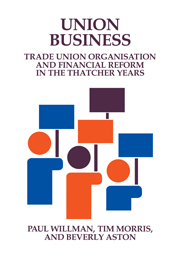Book contents
- Frontmatter
- Contents
- Acknowledgements
- 1 Introduction: unions in the 1980s
- 2 The financial status of British trade unions 1950–1989
- 3 Financial differences between unions
- 4 The role of financial matters in union organisation
- 5 The politics of union finaces
- 6 Union size, growth, and financial performance
- 7 Strike activity and union finances
- 8 The National Union of Mineworkers: strikes and financial disaster
- 9 The GMB: merger and financial reform
- 10 The Amalgamated Engineering Union: back from the brink
- 11 The Banking, Insurance and Finance Union: competitive unionism and financial survival
- 12 The Electrical, Electronic, Telecommunications and Plumbing Trade Union: accountability and financial control
- 13 Conclusions: union business and business unionism
- Appendix 1 Research methods
- Appendix 2 Regression results
- Appendix 3 Questions for finance officers
- Appendix 4 Questions for General Secretaries
- Appendix 5 Questionnaire: trade union finances
- Appendix 6 The number of trade unions
- Notes
- References
- Subject index
- Index of trade unions
- Author index
Appendix 3 - Questions for finance officers
Published online by Cambridge University Press: 11 March 2010
- Frontmatter
- Contents
- Acknowledgements
- 1 Introduction: unions in the 1980s
- 2 The financial status of British trade unions 1950–1989
- 3 Financial differences between unions
- 4 The role of financial matters in union organisation
- 5 The politics of union finaces
- 6 Union size, growth, and financial performance
- 7 Strike activity and union finances
- 8 The National Union of Mineworkers: strikes and financial disaster
- 9 The GMB: merger and financial reform
- 10 The Amalgamated Engineering Union: back from the brink
- 11 The Banking, Insurance and Finance Union: competitive unionism and financial survival
- 12 The Electrical, Electronic, Telecommunications and Plumbing Trade Union: accountability and financial control
- 13 Conclusions: union business and business unionism
- Appendix 1 Research methods
- Appendix 2 Regression results
- Appendix 3 Questions for finance officers
- Appendix 4 Questions for General Secretaries
- Appendix 5 Questionnaire: trade union finances
- Appendix 6 The number of trade unions
- Notes
- References
- Subject index
- Index of trade unions
- Author index
Summary
Income
SUBSCRIPTIONS
How is subscription income collected?
What proportion is check-off, bankers order, or direct debit by hand?
How does the union deal with those in arrears?
How quickly can arrears be identified?
How are membership records kept?
How accurate and up to date are they?
How many different contribution scales are there?
What is the distribution of members across contribution scales?
How are adjustments made to subscription rates?
What are the main pressures to raise subscriptions?
What are the main constraints?
Does the union compete with other unions for membership; if so, which unions?
Is the income from different membership groups monitored?
What proportion of due subscriptions are collected?
OTHER INCOME
What are the other main income sources? (other than investment income)
EXPENDITURE
How is money defrayed between (e.g.) head office, branch, regions?
How are HO/branch/regional budgets calculated?
What restrictions are there on the spending of branch officials, regional officers, department heads, etc.?
What is the fund structure of the union?
Are there separate expenditure accounts for (e.g.) strikes, legal, benefits?
How are decisions taken about major expenditure items, e.g., property /computer purchase, strike pay, recruitment drives?
What are the major recurrent expenditure items?
How many officials are there, and what are they paid?
What does the union spend other than on its members?
INVESTMENTS
What are the union's principal investments
equities
gilts
local government securities
What are its major assets?
Who is responsible for investment and asset management?
Are there trustees; if so, who are they and what are their qualifications?
How are decisions about new investments made?
- Type
- Chapter
- Information
- Union BusinessTrade Union Organisation and Financial Reform in the Thatcher Years, pp. 226 - 227Publisher: Cambridge University PressPrint publication year: 1993



